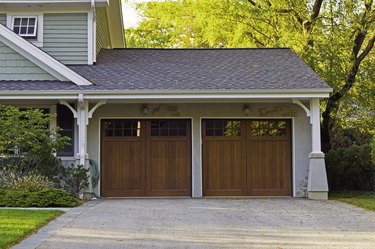6 Simple Ways to Improve Your Garage Door Security
April 12, 2021

Image Credit: Stephen Paul for Hunker
When thinking about home safety and protection, homeowners often overlook garage door security. Doing so creates a weak point in your home security strategy — and burglars know it. Homeowners often rely on a locking door or a garage door opener to secure the door and keep them safe, but crafty burglars can get around these security features quite easily. Fortunately, there are many cheap and easy ways to improve your garage door security to prevent break-ins and give you peace of mind.
1. The Basics: Cameras and Lights
When it comes to security tips, you can't get much simpler than adding some light to your garage area. Many home security systems utilize bright lights and cameras to deter thieves, and these basic tools also work well for garage door security. It is a good idea to install outdoor lights above or next to your garage door. If desired, you can even set your lights to come on automatically with a motion sensor light. Installing a motion sensor light not only makes it easy for your neighbors to see if someone is poking around your house who shouldn't be, but it also helps you see better when you pull into the driveway at night.
Lights often ward off burglars who are nervous about being seen. They are only effective at night, of course, so it is a good idea to pair them with security cameras. Cameras can also work on a motion sensor or can record or stream video all the time. Many thieves will move on if they see that you have video surveillance on your property.
Don't assume that cameras and security lights are complicated and shy away from them. Modern systems are made for DIY installations, and they install much more quickly and easily than old-fashioned security systems — many are even wireless systems.
2. Use Garage Door Locks
It's great if your garage door has a locking handle that opens with a key, but be aware that it might not be enough to keep someone out. Some thieves are quite adept at picking locks, and any lock on the outside of the garage gives them an opportunity to do so. Keeping your locks on the inside of the door is much more secure, and there are several ways to do it.
One way is with a simple bar lock. In this system, you install a small box on one or both sides of your garage door depending on your preference. This box contains a metal bar that you manually slide into the track on your garage door to lock it. The bar makes it almost impossible to lift the garage door. Because you mount these locks on the inside of your garage door, you don't have to worry about a burglar disabling them.
Just as simple and secure is a basic padlock. Simply drill a small hole in your garage door track just above one of the casters. Pop a padlock through the hole and lock it. The lock will work just as a metal bar does, physically preventing the garage door from opening.
Manual locks are quite effective, but they are cumbersome if you are in and out of the garage often. If you are popping to the store for a quick errand, you may want to leave the garage door unlocked so you can easily get back in. As such, locks are often recommended for use when you will be away for a few days on vacation. Many people dislike using them on a daily basis.
3. Install a Manual Release Block
To prevent problems when the power goes out or if your equipment is on the fritz, garage door openers include a manual emergency release cable. Pulling this cable disengages the garage door opener and allows you to lift the door by hand. This is a necessary feature, but it puts a chink in your garage door security armor.
Resourceful thieves will push in the top panel of your garage door, causing it to bow in a bit. Your garage door might not move far, but the thief doesn't need it to do so. He needs just enough of an opening to feed a straightened wire coat hanger into your garage.
On the end of the hanger is a tiny hook that thieves use to "fish" for the manual release cable on your garage door opener. Once he catches it, he can pull the cable and release the door, easily lifting it by hand and entering your garage.
There are a few ways to combat this issue. One is to buy a garage door opener with a more secure cable. Many now require you to pull the release cable straight down and won't release if someone pulls it at an angle.
If your opener lacks this feature, consider installing a garage door shield. This small plastic device truly is shaped like a shield. It mounts on the front of your garage door opener, hanging off it at a 45-degree angle. When a burglar tries to feed a coat hanger through the garage door, the shield serves as a physical barrier that prevents him from reaching the cable.
At about $25, garage door shields do not require a substantial investment. If, however, you want an even less expensive option, simply use a plastic zip tie to secure your release cable to the garage door opener so it can't move. You can then easily cut the zip tie if you need to use the cord later.

Image Credit: saruservice/iStock/GettyImages
4. Get a Smart Garage Door
Lots of household appliances are getting smarter nowadays, and garage door openers are no exception. A smart garage door opener is one that connects to your cellphone using an app. This lets you check the status of your garage door at any time, letting you know whether the door is open or closed.
If you are in a rush one morning and forget to close your garage door, many smart apps will allow you to close it remotely. Others will do so automatically based on a timer. Most range anywhere from two minutes to 20 minutes and will automatically shut the garage door for you once the designated amount of time has passed.
Although largely designed for keeping people out, apps that let you open and close your garage door remotely can also serve to let people in. You can, for example, open the door remotely to admit a plumber or a latchkey kid who forgot her house keys.
Rather than just telling you if the door is open or closed, many apps can send you an alert when the door's status changes. If your garage door mysteriously opens in the middle of the day while you are at work, the app can alert you so you can notify the authorities if necessary.
5. Mind Your Windows
Garage windows often look nice from the street and can let some natural light into your garage workshop, but unfortunately, they also make it a lot easier for thieves and burglars to scout out your stuff. If you have expensive tools and lawn equipment in your garage, it is best not to advertise that fact. Burglars often check for cars as well, deducing that you are not home if both your garage and driveway are empty.
The simple solution to this problem is to apply a light frosting or translucent window film to your garage door windows. This will allow for light but will make it difficult for potential thieves to know whether or not your garage is worth the effort. Extra tip: If your garage has a window, plant a thorny bush underneath it to discourage intruders from using it as an entry point instead if they can't defeat your garage door security.
Image Credit: marchello74/iStock/GettyImages
6. Use Common Sense Garage Door Security Practices
Adding cameras, lights, shields and smart technology can all easily add extra layers of garage door security. However, there are a lot of other ways to protect your garage entrance, and they cost nothing. One is to avoid keeping your garage door opener in your car. A thief who breaks into your car and grabs your garage door opener can have easy access to your home whenever he wants. Try to find a garage door opener with a key fob or keep your opener with your keys so you always remember it.
Always stay in your driveway or in front of your house when leaving to make sure the garage door closes all the way. This assures that it is closed and prevents a thief from wedging something into the door to keep it from closing all the way. An intruder only needs a little gap to roll under the door and gain access to your garage.
Keep any bushes around your garage trimmed so they don't offer would-be thieves a place to hide. Keep your garage door in good repair. If you have been putting off fixing your old garage door, now is the time to do it. It may even be time to replace the door altogether. One good kick and an intruder can get through an old wooden door.
If a thief does gain access to your garage, it is important to minimize the damage and stop him there. Always keep the door between your garage and your house locked. Ideally, a steel door with a deadbolt offers the best protection. It is also a good idea to hang a sturdy steel door if you have a doorway between your garage and the outside, usually referred to as a service door.
Finally, never leave your garage door open. It is tempting to leave the garage door up for convenience when you are doing yard work. It only takes a minute for experienced thieves to grab what they want from your garage and disappear, however, and some simply use the open garage door to access the rest of your home while they know you are busy outside and likely won't catch them. Like windows, open garage doors make it easy for thieves to peruse the contents of your garage and make a mental "shopping list" for later.
Hunker
By MICHELLE MILEY APRIL 8, 2021


